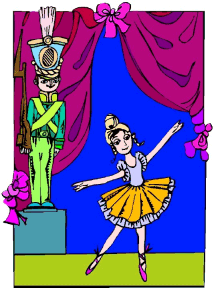Soundtracks:
Jingle All the Way
Fantasia




|
The Nutcracker ballet
 The
ballet "The Nutcracker", ordered by the Royal Opera of Saint
Petersburg is based on a fairy-tale about a nutcracker given as a gift
to child, on Christmas Eve. This suite consists of eight main scenes from
the famous story. The
ballet "The Nutcracker", ordered by the Royal Opera of Saint
Petersburg is based on a fairy-tale about a nutcracker given as a gift
to child, on Christmas Eve. This suite consists of eight main scenes from
the famous story.
At night, the little girl comes to see the toys she has
been given, and falls asleep among them. A war breaks out between the mice
and the toy soldiers, who make the nutcracker their leader. As a decision
is near, seemingly to the mice's favor, the little girl helps the soldiers
by throwing a shoe at the leader mouse's head. The mice flee everywhere,
and the nutcracker turns into a handsome prince. Later, a grand celebration
takes place in the king's palace, in the girl's honor, and in fact most
of the suite's dances are part of this feast.
It is amazing that this optimistic, naive music was composed
at the same time as Tchaikovsky's "the Pathétique" Symphony,
that tragic piece of a musician with a dark secret, one that was considered
a crime in those days. Tchaikovsky's ability to write, simultaneously,
two separate pieces, so contrary in atmosphere and content, and put all
of his skill and soul into both, is particularly remarkable.
The suite's movements are:
|
Overture
|
Reminds a music box tune
|
|
March
|
A dialog between the woodwinds and the strings
|
|
Dance of the Sugar
Plum Fairy
|
Where, for the first time, the celesta
appeared in the orchestra
|
|
Trepak
|
A Cossack dance
|
|
Arabian dance
|
Of Oriental character and style
|
|
Chinese dance
|
The dancers present the tea before its drinking
|
|
Dance of the Reed Flutes
|
Three flutes accompanied by the strings, in pizzicato
|
|
Waltz of the Flowers
|
The famous captivating part
|
|